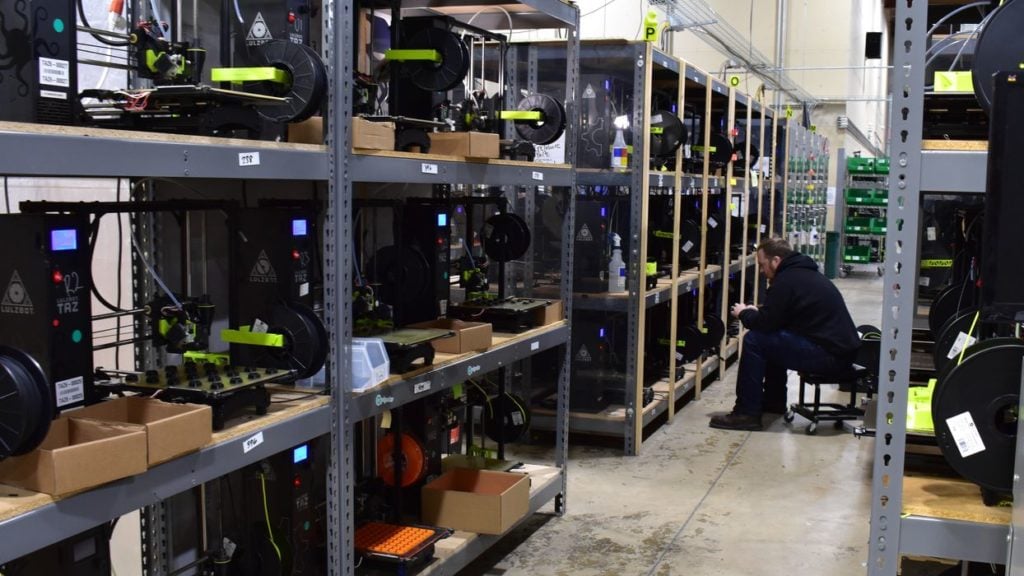
SPONSORED CONTENT
A chat with John Olhoft of FAME 3D revealed something interesting: they operate a truly massive 3D print farm.
With over 300 3D printers in their farm, it is likely to be the second-largest 3D print farm currently operating after Prusa Research’s 500+ unit configuration.
But why would the North Dakota-based manufacturer of LulzBot 3D printers require such a large 3D print farm?

It all has to do with the pandemic. Like many other manufacturers, FAME 3D found themselves short on supplies due to complications with shipments and component providers. Their solution: build as many parts in-house as possible.
That required setting up a rather large 3D print farm, which uses their own LulzBot 3D printers, of course. The implication here is that LulzBots are printing themselves!
I asked Olhoft, President of the company, to describe the farm setup, and he had quite a bit to say:
- The 300 machines operate 24/7, non stop
- Printers used in the farm are identical to those shipped to customers
- 60% of the farm is Mini 2’s due to their small footprint and reliability
- 20% is TAZ Workhorse machines that can produce larger parts
- 15% is TAZ Sidekick machines
- 5% is TAZ Pro machines that offer dual extrusion and can print more complex parts
- Each machine is fed by large 3kg spools of 2.85mm filament, with mostly ABS, PETG and TPU being used, with rare use of ASA for specialized applications
- Monitoring and control is provided by a custom OctoFarm configuration that connects all machines
- Farm operators can work remotely or use tablets to interface with OctoFarm as they move through the farm

Olhoft said their farm currently produces a majority of the parts required to build the various models of LulzBot 3D printers, thus drastically reducing any dependence on faraway suppliers, shipping companies and even import paperwork. Instead, they just print what they need right in the factory as parts are required.
Looking at the images of the farm show a pretty sophisticated setup. There are instructions on how to clean beds, handle ghost prints and more.

One interesting observation is that some of the machines are enclosed. This is accomplished by simply attaching clear acrylic panels around the shelves holding the devices. This is a very straightforward and inexpensive way to close off the machines from ambient air.
With multiple machines inside each enclosure, there is the possibility of maintaining thermal conditions as a group, rather than as individual machines. This should help with print consistency, and these machines are likely used to 3D print ABS, ASA and other challenging materials.

For FAME 3D, the farm provides not only a stream of reliable parts for LulzBot assembly, but also provides quite a few other advantages.
By “eating their own dog food” at scale, LulzBot machine designers will easily be able to detect all kinds of issues long before their customers do. They can also test fixes in ways that other companies can only dream of doing by deploying them to a portion of the farm. The presence of the farm should make LulzBot equipment more reliable in the long term.

It is also possible FAME 3D can perform in depth usage testing of new models before they are released by placing them on the farm. There they will get a significant workout, which could reveal problems that can be quickly dealt with.
The farm also is a living demonstration of the manufacturing capabilities with LulzBot equipment. FAME 3D can literally show their gear performing significant manufacturing to any doubting sales prospect to ally any concerns.
Finally, the farm puts the company in a position where they can learn a great deal about what it takes to operate a 3D print farm at a large scale, and thus build future products towards that goal. In other words, I wouldn’t be surprised if the company eventually comes out with a 3D print farm product.
I’m hoping to get a tour of this facility later this year, so I’ll be able to find out much more about this interesting manufacturing setup.
Meanwhile, when you look at your new LulzBot 3D printer, consider that the parts it’s made from were actually produced on another LulzBot.
Via LulzBot

